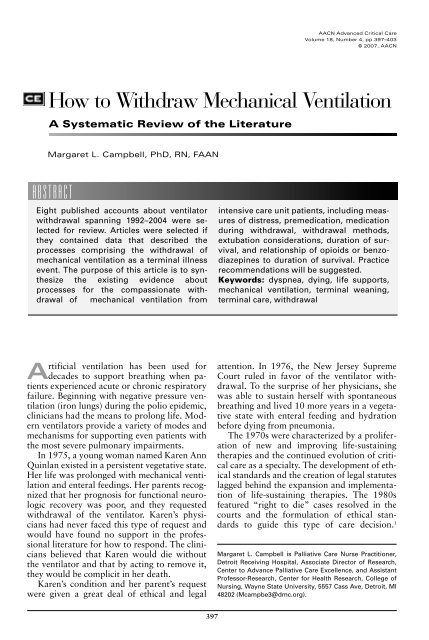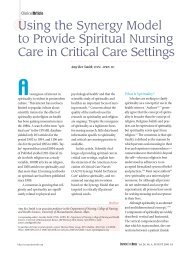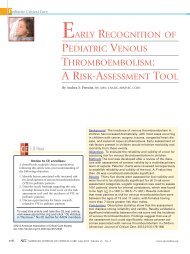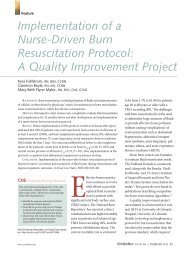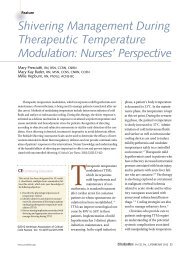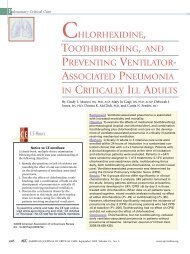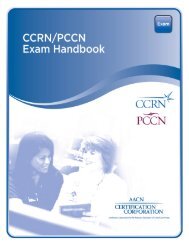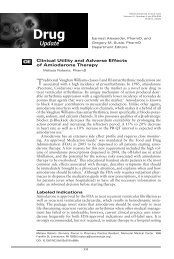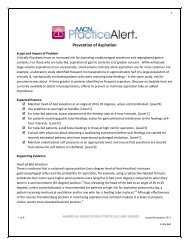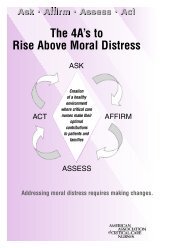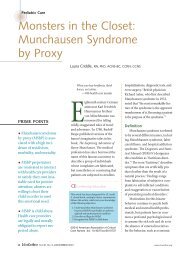How to Withdraw Mechanical Ventilation - American Association of ...
How to Withdraw Mechanical Ventilation - American Association of ...
How to Withdraw Mechanical Ventilation - American Association of ...
You also want an ePaper? Increase the reach of your titles
YUMPU automatically turns print PDFs into web optimized ePapers that Google loves.
AACN18_4_397-403 10/20/07 14:23 Page 397<br />
397<br />
AACN Advanced Critical Care<br />
Volume 18, Number 4, pp.397–403<br />
© 2007, AACN<br />
<strong>How</strong> <strong>to</strong> <strong>Withdraw</strong> <strong>Mechanical</strong> <strong>Ventilation</strong><br />
A Systematic Review <strong>of</strong> the Literature<br />
Margaret L. Campbell, PhD, RN, FAAN<br />
ABSTRACT<br />
Eight published accounts about ventila<strong>to</strong>r<br />
withdrawal spanning 1992–2004 were selected<br />
for review. Articles were selected if<br />
they contained data that described the<br />
processes comprising the withdrawal <strong>of</strong><br />
mechanical ventilation as a terminal illness<br />
event. The purpose <strong>of</strong> this article is <strong>to</strong> synthesize<br />
the existing evidence about<br />
processes for the compassionate withdrawal<br />
<strong>of</strong> mechanical ventilation from<br />
Artificial ventilation has been used for<br />
decades <strong>to</strong> support breathing when patients<br />
experienced acute or chronic respira<strong>to</strong>ry<br />
failure. Beginning with negative pressure ventilation<br />
(iron lungs) during the polio epidemic,<br />
clinicians had the means <strong>to</strong> prolong life. Modern<br />
ventila<strong>to</strong>rs provide a variety <strong>of</strong> modes and<br />
mechanisms for supporting even patients with<br />
the most severe pulmonary impairments.<br />
In 1975, a young woman named Karen Ann<br />
Quinlan existed in a persistent vegetative state.<br />
Her life was prolonged with mechanical ventilation<br />
and enteral feedings. Her parents recognized<br />
that her prognosis for functional neurologic<br />
recovery was poor, and they requested<br />
withdrawal <strong>of</strong> the ventila<strong>to</strong>r. Karen’s physicians<br />
had never faced this type <strong>of</strong> request and<br />
would have found no support in the pr<strong>of</strong>essional<br />
literature for how <strong>to</strong> respond. The clinicians<br />
believed that Karen would die without<br />
the ventila<strong>to</strong>r and that by acting <strong>to</strong> remove it,<br />
they would be complicit in her death.<br />
Karen’s condition and her parent’s request<br />
were given a great deal <strong>of</strong> ethical and legal<br />
intensive care unit patients, including measures<br />
<strong>of</strong> distress, premedication, medication<br />
during withdrawal, withdrawal methods,<br />
extubation considerations, duration <strong>of</strong> survival,<br />
and relationship <strong>of</strong> opioids or benzodiazepines<br />
<strong>to</strong> duration <strong>of</strong> survival. Practice<br />
recommendations will be suggested.<br />
Keywords: dyspnea, dying, life supports,<br />
mechanical ventilation, terminal weaning,<br />
terminal care, withdrawal<br />
attention. In 1976, the New Jersey Supreme<br />
Court ruled in favor <strong>of</strong> the ventila<strong>to</strong>r withdrawal.<br />
To the surprise <strong>of</strong> her physicians, she<br />
was able <strong>to</strong> sustain herself with spontaneous<br />
breathing and lived 10 more years in a vegetative<br />
state with enteral feeding and hydration<br />
before dying from pneumonia.<br />
The 1970s were characterized by a proliferation<br />
<strong>of</strong> new and improving life-sustaining<br />
therapies and the continued evolution <strong>of</strong> critical<br />
care as a specialty. The development <strong>of</strong> ethical<br />
standards and the creation <strong>of</strong> legal statutes<br />
lagged behind the expansion and implementation<br />
<strong>of</strong> life-sustaining therapies. The 1980s<br />
featured “right <strong>to</strong> die” cases resolved in the<br />
courts and the formulation <strong>of</strong> ethical standards<br />
<strong>to</strong> guide this type <strong>of</strong> care decision. 1<br />
Margaret L. Campbell is Palliative Care Nurse Practitioner,<br />
Detroit Receiving Hospital, Associate Direc<strong>to</strong>r <strong>of</strong> Research,<br />
Center <strong>to</strong> Advance Palliative Care Excellence, and Assistant<br />
Pr<strong>of</strong>essor-Research, Center for Health Research, College <strong>of</strong><br />
Nursing, Wayne State University, 5557 Cass Ave, Detroit, MI<br />
48202 (Mcampbe3@dmc.org).
AACN18_4_397-403 10/20/07 14:23 Page 398<br />
CAMPBELL AACN Advanced Critical Care<br />
Numerous cases across the country found<br />
their way in<strong>to</strong> the courts, providing the basis<br />
for case law and eventually statutes <strong>to</strong> guide<br />
clinical decision making. A Presidential Commission<br />
<strong>to</strong> address ethical issues in medicine<br />
was formed; one <strong>of</strong> their reports addressed decisions<br />
<strong>to</strong> forgo life-sustaining treatment. 2 The<br />
Commission examined how decisions were<br />
made <strong>to</strong> forgo therapy, clarified the issues, and<br />
suggested appropriate procedures for making<br />
decisions that are the basis for current practice.<br />
By the early 1990s, clinical standards,<br />
policies, and procedures about forgoing lifesustaining<br />
therapy were in wide use and reflected<br />
broad agreement about the underlying<br />
principles regarding these decisions. The Patient<br />
Self-Determination Act was introduced<br />
<strong>to</strong> provide federal statu<strong>to</strong>ry support <strong>of</strong> the patient’s<br />
right <strong>to</strong> use advance directives. 3<br />
Currently, decisions are made every day <strong>to</strong><br />
forgo life-sustaining therapies. In the vast majority<br />
<strong>of</strong> cases, all parties directly involved—<br />
patients, families, and clinicians—are in agreement<br />
with the decision. Referral <strong>to</strong> a court or<br />
an ethics committee is not necessary, except in<br />
cases characterized by dispute.<br />
Before 1990, the critical care literature focused<br />
on ethical and legal decision making<br />
about forgoing mechanical ventilation. There<br />
was little empiric evidence <strong>to</strong> guide the process;<br />
the “ought <strong>to</strong>” was described but not the “how<br />
<strong>to</strong>.” The earliest article that suggested a method<br />
for ventila<strong>to</strong>r withdrawal was published in<br />
1983 on the basis <strong>of</strong> the processes used in one<br />
unit. Grenvik distinguished terminal weaning<br />
from conventional weaning because terminal<br />
weaning proceeds despite deteriorating vital<br />
signs and other variables. He recommended<br />
continued evaluation <strong>of</strong> blood gases during terminal<br />
weaning <strong>to</strong> moni<strong>to</strong>r the patient’s progress<br />
<strong>to</strong>ward death or successful weaning. Additionally,<br />
he suggested that some patients should remain<br />
intubated if airway obstruction and disconcerting<br />
airway sounds can be anticipated. 4<br />
More recently, Rubenfeld and Crawford<br />
suggested that ventila<strong>to</strong>r withdrawal be treated<br />
similarly <strong>to</strong> other processes or procedures undertaken<br />
in the intensive care unit (ICU). 5 For<br />
example, a plan should be developed for the<br />
ventila<strong>to</strong>r withdrawal that considers what<br />
processes will occur and in what order. Who<br />
will be responsible for those processes?<br />
Some critical care units have turned <strong>to</strong> pro<strong>to</strong>cols,<br />
standing orders, or algorithms <strong>to</strong> guide<br />
the process <strong>of</strong> ventila<strong>to</strong>r withdrawal and an<br />
398<br />
ideal pro<strong>to</strong>col should reflect the state <strong>of</strong> the<br />
science. Thus, the purpose <strong>of</strong> this article is <strong>to</strong><br />
systematically review and synthesize extant evidence<br />
about the processes <strong>of</strong> ventila<strong>to</strong>r withdrawal,<br />
in other words the “how <strong>to</strong>.” This article<br />
does not include a summary <strong>of</strong> the<br />
evidence about communicating <strong>to</strong> make the<br />
decision or caring for families as those <strong>to</strong>pics<br />
are presented in other articles in this issue <strong>of</strong><br />
AACN Advanced Critical Care.<br />
Method<br />
Two electronic databases, MEDLINE (1980<br />
<strong>to</strong> February 2007) and CINAHL (1982 <strong>to</strong><br />
February 2007), were searched for studies in<br />
English using the keywords mechanical ventilation<br />
and withdrawal, life support withdrawal,<br />
ventila<strong>to</strong>r withdrawal, and terminal<br />
weaning. The search yielded 207 citations, <strong>of</strong><br />
which 35 articles reflected the purpose <strong>of</strong> the<br />
review and were selected for evaluation for<br />
inclusion/exclusion criteria. Studies were included<br />
if the target population was mechanically<br />
ventilated adults having ventilation<br />
withdrawn as a part <strong>of</strong> terminal illness care.<br />
Articles were excluded if the data were collected<br />
from a mixed sample <strong>of</strong> patients having<br />
ventilation withdrawn or withheld, if the<br />
sample was less than 12 patients, or if the article<br />
described one or more case reports.<br />
Table 1 summarizes the 8 articles included in<br />
this review.<br />
Data were extracted <strong>to</strong> predesigned summary<br />
tables under the following headings: author(s),<br />
year <strong>of</strong> publication, study design, sample<br />
size, measures <strong>of</strong> distress, premedication or<br />
medication during withdrawal, withdrawal<br />
method(s), extubation considerations, duration<br />
<strong>of</strong> survival, and correlation <strong>of</strong> survival<br />
with administration <strong>of</strong> opioids and sedatives.<br />
Because <strong>of</strong> variability in data extracted, it was<br />
not possible <strong>to</strong> combine the findings <strong>of</strong> different<br />
studies and, therefore, summaries <strong>of</strong> the<br />
variables are reported.<br />
<strong>How</strong> Is Dyspnea or Respira<strong>to</strong>ry<br />
Distress Measured?<br />
Dyspnea, also known as “breathlessness,” is a<br />
nociceptive phenomenon defined as “a subjective<br />
experience <strong>of</strong> breathing discomfort that<br />
consists <strong>of</strong> qualitatively distinct sensations that<br />
vary in intensity. The experience derives from<br />
interactions among multiple physiological, psychological,<br />
social and environmental fac<strong>to</strong>rs,<br />
and may induce secondary physiological and
AACN18_4_397-403 10/20/07 14:23 Page 399<br />
VOLUME 18 • NUMBER 4 • OCTOBER–DECEMBER 2007 HOW TO WITHDRAW MECHANICAL VENTILATION<br />
Table 1: Studies Included in Review <strong>of</strong> the Literature<br />
Authors Year Design N<br />
Faber-Langendoen 1992 Retrospective, descriptive 14<br />
and Bartels 6<br />
Daly et al 7 1996 Retrospective, descriptive 42<br />
Campbell et al 8 1999 Prospective, descriptive, 31<br />
correlational<br />
Mayer and Koss<strong>of</strong>f 9 1999 Retrospective, descriptive, 32<br />
correlational<br />
Ankrom et al 10 2001 Retrospective, descriptive 13<br />
O’Mahony et al 11 2003 Retrospective, descriptive 21<br />
Rocker et al 12 2004 Prospective, descriptive 155<br />
Chan et al 13 2004 Retrospective, descriptive 75<br />
Abbreviation: N, study sample size.<br />
behavioral responses.” 14(p321) Dyspnea can be<br />
perceived and verified only by the person experiencing<br />
it. Many patients who are undergoing<br />
ventila<strong>to</strong>r withdrawal are cognitively impaired<br />
or unconscious as a result <strong>of</strong> underlying<br />
neurologic lesions or hemodynamic, metabolic,<br />
or respira<strong>to</strong>ry dysfunction that produce<br />
cognitive impairment or unconsciousness. 15<br />
Respira<strong>to</strong>ry distress has been characterized as<br />
an observable (behavioral) corollary <strong>to</strong> dyspnea;<br />
the physical and emotional suffering that<br />
results from the experience <strong>of</strong> asphyxiation<br />
that is characterized by behaviors that can be<br />
observed and measured. 16,17 Dyspnea or respira<strong>to</strong>ry<br />
distress is anticipated during ventila<strong>to</strong>r<br />
withdrawal and should be the focus <strong>of</strong> patient<br />
interventions during the process.<br />
Neuromuscular blocking agents (NMBA)<br />
are being used with less frequency in the ICU;<br />
however, when in use, it is impossible <strong>to</strong> assess<br />
the patient’s comfort. Thus, NMBA should be<br />
discontinued with evidence <strong>of</strong> patient neuromuscular<br />
recovery before ventila<strong>to</strong>r withdrawal.<br />
18–20 In some cases, the duration <strong>of</strong> action<br />
<strong>of</strong> these agents is prolonged, such as when<br />
the patient has liver or renal failure and impaired<br />
clearance. Therefore, although controversial,<br />
withdrawal can proceed with careful<br />
attention <strong>to</strong> ensuring patient comfort if an unacceptable<br />
delay in withdrawing mechanical<br />
ventilation occurs because <strong>of</strong> protracted effects<br />
<strong>of</strong> NMBA. 20<br />
Daly et al conducted a chart review and indicated<br />
that medications given during ventila-<br />
399<br />
<strong>to</strong>r withdrawal were titrated <strong>to</strong> maintain a<br />
respira<strong>to</strong>ry rate less than 30 breaths per<br />
minute, or <strong>to</strong> an unspecified appearance <strong>of</strong><br />
comfort. 7 Campbell et al used 3 measures for<br />
distress in a prospective observation study.<br />
The bispectral index <strong>of</strong> EEG, Bizek agitation<br />
scale (BAS), 21 and the COMFORT scale 22 were<br />
used simultaneously <strong>to</strong> assess patients for respira<strong>to</strong>ry<br />
distress, and they strongly correlated<br />
with each other. 8 The measures used were not<br />
specific <strong>to</strong> respira<strong>to</strong>ry distress: BIS is a measure<br />
<strong>of</strong> wakefulness, BAS is an agitation scale,<br />
and the COMFORT scale is intended <strong>to</strong> measure<br />
distress in infants.<br />
O’Mahoney et al reported after retrospective<br />
chart review that initiating or escalating<br />
sedation or analgesia was done if the patient<br />
showed unspecified signs <strong>of</strong> dyspnea, agitation,<br />
or anxiety, and <strong>to</strong> keep the respira<strong>to</strong>ry<br />
rate below 28 breaths/minute. 11 Additionally,<br />
they reported that sedating medications were<br />
administered if the respira<strong>to</strong>ry rate increased<br />
by 50% over baseline or if accessory muscle<br />
use or nasal flaring was apparent.<br />
Subjectivity characterizes the measures<br />
used. Nurse-nurse interrater reliability was not<br />
measured or reported in the previous studies,<br />
nor were operational definitions provided for<br />
“distress,” “signs <strong>of</strong> dyspnea,” “anxiety,” or<br />
“agitation.” Skill is required <strong>to</strong> detect nuances<br />
<strong>of</strong> behaviors, particularly when the patient is<br />
unable <strong>to</strong> validate the nurse’s assessment. Evidence<br />
is needed <strong>to</strong> reliably identify the behaviors<br />
that signify respira<strong>to</strong>ry distress, especially
AACN18_4_397-403 10/20/07 14:23 Page 400<br />
CAMPBELL AACN Advanced Critical Care<br />
when patients are unable <strong>to</strong> reliably provide a<br />
self-report about their experience. Recent investigation<br />
<strong>of</strong> the reliability and validity <strong>of</strong> a<br />
Respira<strong>to</strong>ry Distress Observation Scale suggests<br />
that there may be common behaviors displayed<br />
by patients in response <strong>to</strong> hypercarbia,<br />
hypoxemia, or inspira<strong>to</strong>ry effort, including<br />
tachycardia, tachypnea, accessory muscle use,<br />
restlessness, nasal flaring, grunting at end-expiration,<br />
and a fearful facial expression. 23<br />
Some would argue that routine premedication<br />
with opioids and sedatives will prevent distress<br />
during ventila<strong>to</strong>r withdrawal, however, many<br />
clinicians fear hastening patient death and are<br />
reluctant <strong>to</strong> medicate without clear evidence <strong>of</strong><br />
patient distress.<br />
Recommendation<br />
More studies are needed <strong>to</strong> identify reliable behaviors<br />
that signify respira<strong>to</strong>ry distress when<br />
the patient is unable <strong>to</strong> generate a self-report.<br />
Brain-dead patients by definition will not<br />
show distress, cough, gag, or breath during or<br />
following ventila<strong>to</strong>r withdrawal, and sedation<br />
or analgesia is not indicated. Coma<strong>to</strong>se patients<br />
are unlikely <strong>to</strong> demonstrate distress except<br />
for, perhaps, tachypnea and tachycardia. 8<br />
Initiation and escalation <strong>of</strong> sedatives and opioids<br />
should be guided by patient behaviors.<br />
Premedication<br />
Four investiga<strong>to</strong>rs reported about premedication.<br />
Campbell et al recommended premedication<br />
with morphine and/or a benzodiazepine<br />
if the patient showed signs <strong>of</strong> distress before<br />
withdrawal or if the conscious patient desired<br />
medication. Because subjects in the sample<br />
were coma<strong>to</strong>se, only 13% <strong>of</strong> patients were<br />
premedicated; an average Glasgow Coma<br />
Scale (GCS) score <strong>of</strong> 7 was reported for those<br />
premedicated and 4 for those with no premedication.<br />
8 Investiga<strong>to</strong>rs at the University <strong>of</strong><br />
Washing<strong>to</strong>n reported progressive escalation<br />
<strong>of</strong> infusions <strong>of</strong> opioids or benzodiazepines in<br />
the 8 hours preceding a planned ventila<strong>to</strong>r<br />
withdrawal. The justification for dose escalation<br />
was not reported from this retrospective<br />
review. 13 Ankrom et al reported that “small”<br />
doses <strong>of</strong> morphine and a benzodiazepine<br />
were given before ventila<strong>to</strong>r withdrawal, but<br />
doses and indications were not reported. 10<br />
O’Mahoney reported premedication if the<br />
patient was alert or had a his<strong>to</strong>ry <strong>of</strong> recent<br />
agitation before the withdrawal. 11<br />
400<br />
Medication During or<br />
After <strong>Withdraw</strong>al<br />
Variance in reporting characterized the descriptions<br />
<strong>of</strong> medications used during ventila<strong>to</strong>r<br />
withdrawal. All investiga<strong>to</strong>rs used an opioid,<br />
usually morphine, and some used a benzodiazepine<br />
occasionally or always. Table 2 is a<br />
summary <strong>of</strong> the morphine characteristics<br />
reported across investigations. As seen, doses<br />
ranged from very small <strong>to</strong> very large. As discussed,<br />
most studies did not report how distress<br />
was measured or how dose escalation was<br />
determined.<br />
Recommendation<br />
As is the standard with pain management, opioids<br />
should be initiated <strong>to</strong> signs <strong>of</strong> distress and<br />
the advice <strong>to</strong> “start low and titrate slowly” is<br />
sage. Anticipa<strong>to</strong>ry premedication is a sound<br />
practice if distress is already evident and if distress<br />
can be anticipated. There is no justification<br />
for medicating a brain-dead patient, and<br />
one could argue that the patient in coma with<br />
only minimal brainstem function is also unlikely<br />
<strong>to</strong> experience distress. Doses that correspond<br />
<strong>to</strong> cus<strong>to</strong>mary dosing for the treatment<br />
<strong>of</strong> dyspnea should guide dosing during ventila<strong>to</strong>r<br />
withdrawal. Documentation <strong>of</strong> the signs <strong>of</strong><br />
distress and rationale for dose escalation is important<br />
<strong>to</strong> ensure continuity across pr<strong>of</strong>essional<br />
caregivers and <strong>to</strong> prevent overmedication<br />
and the appearance <strong>of</strong> hastening death.<br />
Weaning Method<br />
Terminal extubation is characterized by ceasing<br />
ventila<strong>to</strong>ry support and removing the endotracheal<br />
tube in one step. Extubation was<br />
the only method used in 2 studies. 9,11, Terminal<br />
weaning is a process <strong>of</strong> step-wise, gradual reductions<br />
in oxygen and ventilation, terminating<br />
with placement on a t-piece or with extubation.<br />
Rapid terminal weaning was the only<br />
method used in one study with an average<br />
weaning interval <strong>of</strong> 15 minutes. 8 In 2 studies,<br />
investiga<strong>to</strong>rs reported various methods used<br />
with no rationale provided for choice <strong>of</strong><br />
method. 6,7<br />
In a survey <strong>of</strong> physician practices related <strong>to</strong><br />
ventila<strong>to</strong>r withdrawal, investiga<strong>to</strong>rs found<br />
that surgeons and anesthesiologists preferred<br />
terminal weaning compared with internists<br />
and pediatricians who preferred extubation. 24<br />
It is interesting <strong>to</strong> note that physician rather<br />
than patient characteristics contributed <strong>to</strong>
AACN18_4_397-403 10/20/07 14:23 Page 401<br />
VOLUME 18 • NUMBER 4 • OCTOBER–DECEMBER 2007 HOW TO WITHDRAW MECHANICAL VENTILATION<br />
Table 2: Summary <strong>of</strong> Reports <strong>of</strong> Morphine Administered During Ventila<strong>to</strong>r <strong>Withdraw</strong>al<br />
Author(s) Total morphine (duration) Average hourly dose Range <strong>of</strong> dosing<br />
Faber-Langendoen NR NR 0–80 mg/h<br />
and Bartels 6<br />
Daly et al 7 NR NR 1–59 mg/h<br />
Campbell et al 8 36 � 10 mg (24 h from 5.5 mg/h NR<br />
beginning <strong>of</strong> withdrawal)<br />
Mayer and Koss<strong>of</strong>f 9 6–456 mg (30 h from 6.3 mg/h 2.5–20 mg/h<br />
beginning <strong>of</strong> withdrawal)<br />
Ankrom et al 10 206 � 265 mg (patient survived NR NR<br />
�30 min) 78 � 14 mg (patient<br />
survived longer than 30 min)<br />
O’Mahoney et al 11 12 mg (extubation until death) 6 mg/h 1–50 mg/h<br />
Rocker et al 12 24 mg (4 h before death) 24 mg/h median 2–340 mg/h<br />
Chan et al 13 81 mg (24 h before death) Increased from 4 mg/h NR<br />
<strong>to</strong> 16.2 mg/h during<br />
interval before<br />
withdrawal<br />
Abbreviation: NR, not reported.<br />
choice <strong>of</strong> method. There are no known investigations<br />
that compare these methods.<br />
Recommendation<br />
With no comparative evidence <strong>to</strong> support one<br />
method over another, it is difficult <strong>to</strong> make a<br />
recommendation. Rapid terminal weaning<br />
may afford the clinician with the most control<br />
because it allows for careful, sequential adjustments<br />
<strong>to</strong> the ventila<strong>to</strong>r with precise titration <strong>of</strong><br />
medications <strong>to</strong> ensure patient comfort. Continuous<br />
patient moni<strong>to</strong>ring with readily accessible<br />
opioids and sedatives will afford the patient<br />
and family comfort regardless <strong>of</strong> method<br />
employed.<br />
Extubation Considerations<br />
Campbell et al were the only investiga<strong>to</strong>rs who<br />
recommended extubation as a separate decision<br />
based on the patient’s airway integrity,<br />
volume <strong>of</strong> pulmonary secretions, and ability <strong>to</strong><br />
experience distress. Of coma<strong>to</strong>se patients,<br />
35% were extubated after rapid terminal<br />
weaning. Of note, survival was longer for<br />
those who were extubated (85.3 � 35 hours)<br />
compared with the patients who remained<br />
intubated (12.95 � 4.96 hours; P � .01). 8<br />
Rocker reported no significant difference in<br />
duration <strong>of</strong> survival when the patients who<br />
were extubated (median 1.1 hours) were com-<br />
401<br />
pared with those who had either a tracheos<strong>to</strong>my<br />
or endotracheal tube maintained<br />
(median 1.2 hours). 12<br />
Recommendation<br />
Removal <strong>of</strong> the endotracheal tube should be<br />
performed whenever possible because <strong>of</strong> patient<br />
comfort and the aesthetic appearance <strong>of</strong><br />
the patient. <strong>How</strong>ever, in some cases, airway<br />
compromise can be anticipated, such as when<br />
the patient has a swollen, protuberant <strong>to</strong>ngue,<br />
or has no gag or cough reflexes. In cases <strong>of</strong> airway<br />
compromise, the disconcerting noises<br />
may be more distressing <strong>to</strong> the attendant family<br />
than the presence <strong>of</strong> the tube. Aerosolized<br />
racemic epinephrine is a useful intervention <strong>to</strong><br />
reduce stridor after extubation. Family counseling<br />
about usual noises that can be expected<br />
and cause no distress should be done prior <strong>to</strong><br />
extubation.<br />
Duration <strong>of</strong> Survival<br />
All the investiga<strong>to</strong>rs reported about duration<br />
<strong>of</strong> survival. In 4 studies, patients who died following<br />
ventila<strong>to</strong>r withdrawal comprised the<br />
sample; thus 100% <strong>of</strong> patients died. 9,12,13,25 All<br />
the patients who were withdrawn died in 2<br />
studies, 7,10 and 2 brain-dead patients were included<br />
in the sample from Daly et al. 7<br />
Campbell et al reported that <strong>of</strong> 31 coma<strong>to</strong>se
AACN18_4_397-403 10/20/07 14:23 Page 402<br />
CAMPBELL AACN Advanced Critical Care<br />
patients, 2 patients (6%) survived <strong>to</strong> hospital<br />
discharge, and O’Mahoney et al discharged 3<br />
<strong>of</strong> 21 (14%) patients after ventila<strong>to</strong>r withdrawal.<br />
8,11<br />
Across studies the duration <strong>of</strong> survival<br />
ranged from 2 minutes <strong>to</strong> 9 days after ventila<strong>to</strong>r<br />
withdrawal. Median survival across<br />
studies ranged from 35 minutes 13 <strong>to</strong> 7.5<br />
hours. 9 Campbell et al reported no relationship<br />
between duration <strong>of</strong> survival and use <strong>of</strong><br />
sedation/analgesia, GCS score, or PaO 2/FiO 2<br />
but there was a significant inverse correlation<br />
with illness severity measured with<br />
APACHE II 26 (r ��0.42, P � .05). 8 Mayer<br />
et al also found no relationship between duration<br />
<strong>of</strong> survival and GCS score. 9 Ankrom<br />
et al reported no correlation between analgesia<br />
use and duration <strong>of</strong> survival; however,<br />
patients who died in less than 30 minutes received<br />
an average <strong>to</strong>tal morphine dose <strong>of</strong><br />
206 � 265 mg morphine, and those who<br />
died more than 30 minutes after withdrawal<br />
received an average <strong>of</strong> 78 � 111 mg morphine.<br />
10 This suggests a clinical significance,<br />
although the analysis with a small sample<br />
and a large standard deviation may not have<br />
yielded a statistical significance.<br />
Of note, both Campbell et al and Chan et al<br />
reported no significant relationship between<br />
analgesia/sedation and duration <strong>of</strong> survival. 8,13<br />
<strong>How</strong>ever, with similar average reported GCS<br />
scores (5.3 vs 4), Campbell reported an average<br />
<strong>to</strong>tal morphine dose <strong>of</strong> 36 mg for the 24hour<br />
period after withdrawal and an average<br />
survival <strong>of</strong> 24.2 hours (median 2.3 hours).<br />
This contrasts sharply with the average <strong>to</strong>tal<br />
morphine dose <strong>of</strong> 81 mg for the 24-hour period<br />
before death and the median survival after<br />
ventila<strong>to</strong>r withdrawal <strong>of</strong> 35 minutes<br />
(range, 1 minute <strong>to</strong> 14.8 hours).<br />
Summary<br />
Small samples and largely retrospective chart<br />
reviews characterize the body <strong>of</strong> evidence<br />
about processes for ventila<strong>to</strong>r withdrawal.<br />
Thus, it seems fair <strong>to</strong> say that the evidence is<br />
largely lacking <strong>to</strong> predict the best method that<br />
ensures patient comfort without hastening<br />
death. Palliation versus hastening death may<br />
be difficult <strong>to</strong> distinguish in this context because<br />
the patients are <strong>of</strong>ten near death before<br />
the ventila<strong>to</strong>r is withdrawn. The cited research<br />
is not conclusive <strong>to</strong> make recommendations<br />
in all cases <strong>of</strong> ventila<strong>to</strong>r withdrawal.<br />
Therefore, a number <strong>of</strong> suggested processes<br />
402<br />
may be useful in this clinical context as well as<br />
with a team approach <strong>to</strong> the procedure and<br />
patient care.<br />
First, a common measure <strong>of</strong> dyspnea or respira<strong>to</strong>ry<br />
distress should be identified and used<br />
across clinicians <strong>to</strong> guide the initiation and escalation<br />
<strong>of</strong> opioids or sedatives, such as noting<br />
the presence <strong>of</strong> behaviors specific <strong>to</strong> respira<strong>to</strong>ry<br />
distress. Additionally, moni<strong>to</strong>ring the patient<br />
for signs <strong>of</strong> affective distress, such as fear,<br />
is essential. Brain-dead patients do not experience<br />
or display signs <strong>of</strong> distress.<br />
Premedication or medication during and<br />
following withdrawal <strong>of</strong> mechanical ventilation<br />
with opioids and benzodiazepines is<br />
useful if the patient is experiencing distress<br />
before withdrawal or likely <strong>to</strong> experience distress<br />
during or after. Brain-dead patients do<br />
not require medication because there is no<br />
distress. Coma<strong>to</strong>se patients may require little<br />
or no analgesia or sedation unless objective<br />
signs <strong>of</strong> respira<strong>to</strong>ry distress are apparent.<br />
Doses should be initiated according <strong>to</strong> the patient’s<br />
<strong>to</strong>lerance and escalated only <strong>to</strong> signs or<br />
reports <strong>of</strong> distress.<br />
Every attempt should be made <strong>to</strong> extubate<br />
patients after ceasing mechanical ventilation<br />
because the endotracheal tube is a source <strong>of</strong><br />
iatrogenic discomfort. <strong>How</strong>ever, in some<br />
cases, particularly when the patient is unresponsive,<br />
it may be best <strong>to</strong> keep the endotracheal<br />
tube, such as when the <strong>to</strong>ngue is<br />
swollen, when gag and cough reflexes are absent,<br />
or when there is a large volume <strong>of</strong> pulmonary<br />
secretions. Studies are needed <strong>to</strong> identify<br />
best methods.<br />
References<br />
1. Meisel A. The legal consensus about forgoing life-sustaining<br />
treatment: its status and its prospects. Kennedy<br />
Inst Ethics J. 1993;2:309–335.<br />
2. President’s Commission for the Study <strong>of</strong> Ethical Problems<br />
in Medicine and Behavioral Research. Deciding <strong>to</strong><br />
Forego Life-Sustaining Treatment. Washing<strong>to</strong>n, DC: US<br />
Government Printing Office; 1983.<br />
3. Omnibus Budget Reconciliation Act. Washing<strong>to</strong>n, DC:<br />
Government Printing Office; 1990.<br />
4. Grenvik A. “Terminal weaning”: discontinuance <strong>of</strong> lifesupport<br />
therapy in the terminally ill patient. Crit Care<br />
Med. 1983;11:394–395.<br />
5. Rubenfeld GD, Crawford SW. Principles and practice <strong>of</strong><br />
withdrawing life-sustaining treatment in the ICU. In:<br />
Curtis JR, Rubenfeld GD, eds. Managing Death in the<br />
ICU: The Transition From Cure <strong>to</strong> Comfort. New York:<br />
Oxford University Press; 2001:127–147.<br />
6. Faber-Langendoen K, Bartels DM. Process <strong>of</strong> forgoing<br />
life-sustaining treatment in a university hospital: an empirical<br />
study. Crit Care Med. 1992;20(5):570–577.<br />
7. Daly BJ, Thomas D, Dyer MA. Procedures used in withdrawal<br />
<strong>of</strong> mechanical ventilation. Am J Crit Care. 1996;<br />
5:331–338.
AACN18_4_397-403 10/20/07 14:23 Page 403<br />
VOLUME 18 • NUMBER 4 • OCTOBER–DECEMBER 2007 HOW TO WITHDRAW MECHANICAL VENTILATION<br />
8. Campbell ML, Bizek KS, Thill M. Patient responses during<br />
rapid terminal weaning from mechanical ventilation:<br />
a prospective study. Crit Care Med. 1999;27(1):73–77.<br />
9. Mayer SA, Koss<strong>of</strong>f SB. <strong>Withdraw</strong>al <strong>of</strong> life support in the<br />
neurological intensive care unit. Neurol. 1999;52(8):<br />
1602–1609.<br />
10. Ankrom M, Zelesnick L, Bar<strong>of</strong>sky I, Georas S, Finucane<br />
TE, Greenough WB, III. Elective discontinuation <strong>of</strong> lifesustaining<br />
mechanical ventilation on a chronic ventila<strong>to</strong>r<br />
unit. J Am Geriatr Soc. 2001;49(11):1549–1554.<br />
11. O’Mahony S, McHugh M, Zallman L, Selwyn P. Ventila<strong>to</strong>r<br />
withdrawal: procedures and outcomes. J Pain Symp<strong>to</strong>m<br />
Manag. 2003;26:954–961.<br />
12. Rocker GM, Heyland DK, Cook DJ, Dodek PM,<br />
Kutsogiannis DJ, O’Callaghan CJ. Most critically ill patients<br />
are perceived <strong>to</strong> die in comfort during withdrawal<br />
<strong>of</strong> life support: a Canadian multicentre study. Can J<br />
Anesth. 2004;51:623–630.<br />
13. Chan JD, Treece PD, Engelberg RA, et al. Narcotic and<br />
benzodiazepine use after withdrawal <strong>of</strong> life support: association<br />
with time <strong>to</strong> death? Chest. 2004;126:286–293.<br />
14. <strong>American</strong> Thoracic Society. Dyspnea. Mechanisms, assessment,<br />
and management: a consensus statement.<br />
<strong>American</strong> Thoracic Society. Am J Respir Crit Care Med.<br />
1999;159(1):321–340.<br />
15. Campbell ML, Thill MC. Impact <strong>of</strong> patient consciousness<br />
on the intensity <strong>of</strong> the do-not-resuscitate therapeutic<br />
plan. Am J Crit Care. 1996;5(5):339–345.<br />
16. Campbell ML. Terminal dyspnea and respira<strong>to</strong>ry distress.<br />
Crit Care Clin. 2004;20(3):403–417.<br />
403<br />
17. Campbell ML. Fear and pulmonary stress behaviors <strong>to</strong><br />
an asphyxial threat across cognitive states. Res Nurs<br />
Health. In press.<br />
18. Rush<strong>to</strong>n C, Terry PB. Neuromuscular blockade and ventila<strong>to</strong>r<br />
withdrawal: ethical controversies. Am J Crit Care.<br />
1995;4:112–115.<br />
19. Truog RD, Burns JP. To breathe or not <strong>to</strong> breathe. J Clin<br />
Ethics. 1994;5(1):39–42.<br />
20. Truog RD, Campbell ML, Curtis JR, et al. Recommendations<br />
for end-<strong>of</strong>-life care in the intensive care unit. Crit<br />
Care Med. In press.<br />
21. Bizek K. Optimizing sedation in critically ill, mechanically<br />
ventilated patients. Crit Care Nurs Clin North Am.<br />
1995;7:315–325.<br />
22. Ambuel B, Hamlett KW, Marx CM, Blumer JL. Assessing<br />
distress in pediatric intensive care environments:<br />
the COMFORT scale. J Pediatr Psychol. 1992;17:<br />
95–109.<br />
23. Campbell ML. Psychometric testing <strong>of</strong> a respira<strong>to</strong>ry distress<br />
observation scale. J Palliat Med. In press.<br />
24. Faber-Langendoen K. The clinical management <strong>of</strong> dying<br />
patients receiving mechanical ventilation. A survey <strong>of</strong><br />
physician practice. Chest. 1994;106(3):880–888.<br />
25. Faber-Langendoen K, Spomer A, Ingbar D. A prospective<br />
study <strong>of</strong> withdrawing mechanical ventilation from<br />
dying patients. Am J Respir Crit Care Med. 1996;<br />
153:45.<br />
26. Knaus WA, Drapter EA, Wagner DP, Zimmerman JE.<br />
APACHE II: a severity <strong>of</strong> disease classification system.<br />
Crit Care Med. 1985;13:818–829.
AACN18_4_404-405 17/11/07 1:19 Page 404<br />
Test writer: John P. Harper, MSN, RN, BC<br />
Contact hours: 1.0<br />
Category: A, Synergy CERP A<br />
Passing score: 9 correct (75%)<br />
CE Test Instructions<br />
AACN<br />
ADVANCED CRITICAL CARE<br />
To receive CE credit for this test (ID# CI1841), mark your answers on the form below, complete the<br />
enrollment information and submit it with the $10 processing fee (nonmembers only; payable in US<br />
funds) <strong>to</strong> the <strong>American</strong> <strong>Association</strong> <strong>of</strong> Critical-Care Nurses (AACN). Answer forms must be postmarked<br />
by December 1, 2009. Within 3 <strong>to</strong> 4 weeks <strong>of</strong> AACN’s receiving your test form, you will receive<br />
an AACN CE certificate.<br />
The <strong>American</strong> <strong>Association</strong> <strong>of</strong> Critical-Care Nurses (AACN) is accredited as a provider <strong>of</strong> continuing nursing education by the<br />
<strong>American</strong> Nurses Credentialing Center’s Commission on Accreditation.<br />
AACN has been approved as a provider <strong>of</strong> continuing education in nursing by the State Boards <strong>of</strong> Nursing <strong>of</strong> Alabama<br />
(#ABNP0062), California (#01036), Florida (#FBN2464), Iowa (#332) and Louisiana (#ABN12). AACN programming meets<br />
the standards for most other states requiring manda<strong>to</strong>ry continuing education credit for relicensure.<br />
CE Test Form<br />
<strong>How</strong> <strong>to</strong> <strong>Withdraw</strong> <strong>Mechanical</strong> <strong>Ventilation</strong>: A Systematic<br />
Review <strong>of</strong> the Literature<br />
Mark your answers clearly in the appropriate box. There is only one correct answer<br />
per question. You may pho<strong>to</strong>copy this form.<br />
A B C D<br />
1. ❍ ❍ ❍ ❍<br />
2. ❍ ❍ ❍ ❍<br />
3. ❍ ❍ ❍ ❍<br />
A B C D<br />
4. ❍ ❍ ❍ ❍<br />
5. ❍ ❍ ❍ ❍<br />
6. ❍ ❍ ❍ ❍<br />
404<br />
A B C D<br />
7. ❍ ❍ ❍ ❍<br />
8. ❍ ❍ ❍ ❍<br />
9. ❍ ❍ ❍ ❍<br />
A B C D<br />
10. ❍ ❍ ❍ ❍<br />
11. ❍ ❍ ❍ ❍<br />
12. ❍ ❍ ❍ ❍<br />
Last name_________________________________ First name______________________ AACN Member #______________________<br />
Address____________________________________________________________________________________________________<br />
City____________________________________________________ State___________________________ ZIP__________________<br />
Telephone____________________________________________ E-mail __________________________________________________<br />
State <strong>of</strong> licensure _____________________________________ License No(s). ___________________________________________<br />
Payment by ❑ Visa ❑ Mastercard ❑ <strong>American</strong> Express ❑ Discover ❑ Check<br />
Card #_____________________________________ Exp. Date _________<br />
Signature____________________________________________________<br />
Program Evaluation<br />
Yes No<br />
Objective 1 was met ❍ ❍<br />
Objective 2 was met ❍ ❍<br />
Objective 3 was met ❍ ❍<br />
The content was appropriate ❍ ❍<br />
My expectations were met ❍ ❍<br />
This method <strong>of</strong> CE is effective ❍ ❍<br />
for this content<br />
Mail To: AACN<br />
101 Columbia<br />
Aliso Viejo, CA 92656<br />
Test ID#: CI1841<br />
FORM EXPIRES<br />
December 1, 2009<br />
Fee: $10<br />
The level <strong>of</strong> difficulty <strong>of</strong> this test was:<br />
❍ easy ❍ medium ❍ difficult<br />
To complete this program, it <strong>to</strong>ok me<br />
____________ hours/minutes.<br />
Or fax <strong>to</strong> 949-362-2021<br />
Or take test online at<br />
www.aacn.org>Continuing Education
AACN18_4_404-405 17/11/07 1:19 Page 405<br />
CE Test Questions<br />
<strong>How</strong> <strong>to</strong> <strong>Withdraw</strong> <strong>Mechanical</strong> <strong>Ventilation</strong>: A Systematic<br />
Review <strong>of</strong> the Literature<br />
Objectives:<br />
Upon completion <strong>of</strong> this article, the reader will be able <strong>to</strong>:<br />
1. Identify 3 patient behaviors that signify respira<strong>to</strong>ry distress.<br />
2. Describe 2 weaning methods for ventila<strong>to</strong>r withdrawal.<br />
3. Discuss the processes for compassionate withdrawal <strong>of</strong> mechanical ventilation.<br />
1. Which <strong>of</strong> the following patients was involved in a US<br />
Supreme Court ruling in favor <strong>of</strong> ventila<strong>to</strong>r withdrawal?<br />
a. Karen Andrews<br />
b. Nancy Cruzan<br />
c. Terry Schiavo<br />
d. Karen Ann Quinlan<br />
2. Which <strong>of</strong> the following patient rights is provided for in<br />
the Patient Self-Determination Act?<br />
a. Advance directives<br />
b. Ventila<strong>to</strong>r withdrawal<br />
c. Removal <strong>of</strong> feeding tube<br />
d. Physician-assisted suicide<br />
3. Which <strong>of</strong> the following symp<strong>to</strong>ms is anticipated during<br />
ventila<strong>to</strong>r withdrawal and should be the focus <strong>of</strong><br />
interventions during the withdrawal process?<br />
a. Pain<br />
b. Death<br />
c. Dyspnea<br />
d. Agitation<br />
4. Which <strong>of</strong> the following behaviors may be displayed by<br />
patients in response <strong>to</strong> hypercarbia or hypoxemia?<br />
a. Facial grimacing<br />
b. Nasal flaring<br />
c. Grunting during inspiration<br />
d. Stridor<br />
5. Which <strong>of</strong> the following should guide initiation and<br />
escalation <strong>of</strong> sedatives and opioids during ventila<strong>to</strong>r<br />
withdrawal?<br />
a. Routine administration throughout the withdrawal process<br />
b. Blood pressure<br />
c. Signs <strong>of</strong> respira<strong>to</strong>ry distress<br />
d. Glascow coma scale<br />
6. Which <strong>of</strong> the following medications was most<br />
commonly used by investiga<strong>to</strong>rs during ventila<strong>to</strong>r<br />
withdrawal?<br />
a. Morphine<br />
b. Lorazepam<br />
c. Fentanyl<br />
d. Prop<strong>of</strong>ol<br />
405<br />
7. Which <strong>of</strong> the following weaning intervals was used by<br />
investiga<strong>to</strong>rs during rapid terminal weaning?<br />
a. 1 <strong>to</strong> 5 minutes<br />
b. 15 <strong>to</strong> 20 minutes<br />
c. 30 <strong>to</strong> 45 minutes<br />
d. 60 <strong>to</strong> 90 minutes<br />
8. The terminal extubation method <strong>of</strong> weaning:<br />
a. is based on physician preference.<br />
b. should not be used if strider is present.<br />
c. is the safest method <strong>of</strong> withdrawal <strong>of</strong> mechanical ventila<strong>to</strong>r.<br />
d. should be done without the administration <strong>of</strong> opioids or<br />
benzodiazepines.<br />
9. Which <strong>of</strong> the following is a useful aerosol medication<br />
<strong>to</strong> reduce stridor after extubation?<br />
a. Epinephrine<br />
b. Metaproterenol<br />
c. Ephedrine<br />
d. Ipratroprium bromide<br />
10. Which <strong>of</strong> the following had a significant inverse<br />
correlation with duration <strong>of</strong> survival after ventila<strong>to</strong>r<br />
withdrawal?<br />
a. Ramsey sedation scale score<br />
b. Glascow coma scale score<br />
c. PaO2/FIO2 ratio<br />
d. APACHE II score<br />
11. Which <strong>of</strong> the following would not preclude extubation<br />
after ceasing mechanical ventilation?<br />
a. Swollen <strong>to</strong>ngue<br />
b. Absent gag reflex<br />
c. Stridor<br />
d. Increased secretions<br />
12. Which <strong>of</strong> the following was the smallest average<br />
hourly dose <strong>of</strong> morphine used by investiga<strong>to</strong>rs for<br />
ventila<strong>to</strong>r withdrawal?<br />
a. 3 mg/h<br />
b. 5.5 mg/h<br />
c. 6 mg/h<br />
d. 8.5 mg/h


